Dine
You say … “TOMATO”
And Christiana Kaluscha says “I can’t wait!” It’s tomato season in the Pacific with the Suva, Honiara and Port Vila markets in particular overflowing with scarlet goodness and a variety for every recipe.
November 24, 2020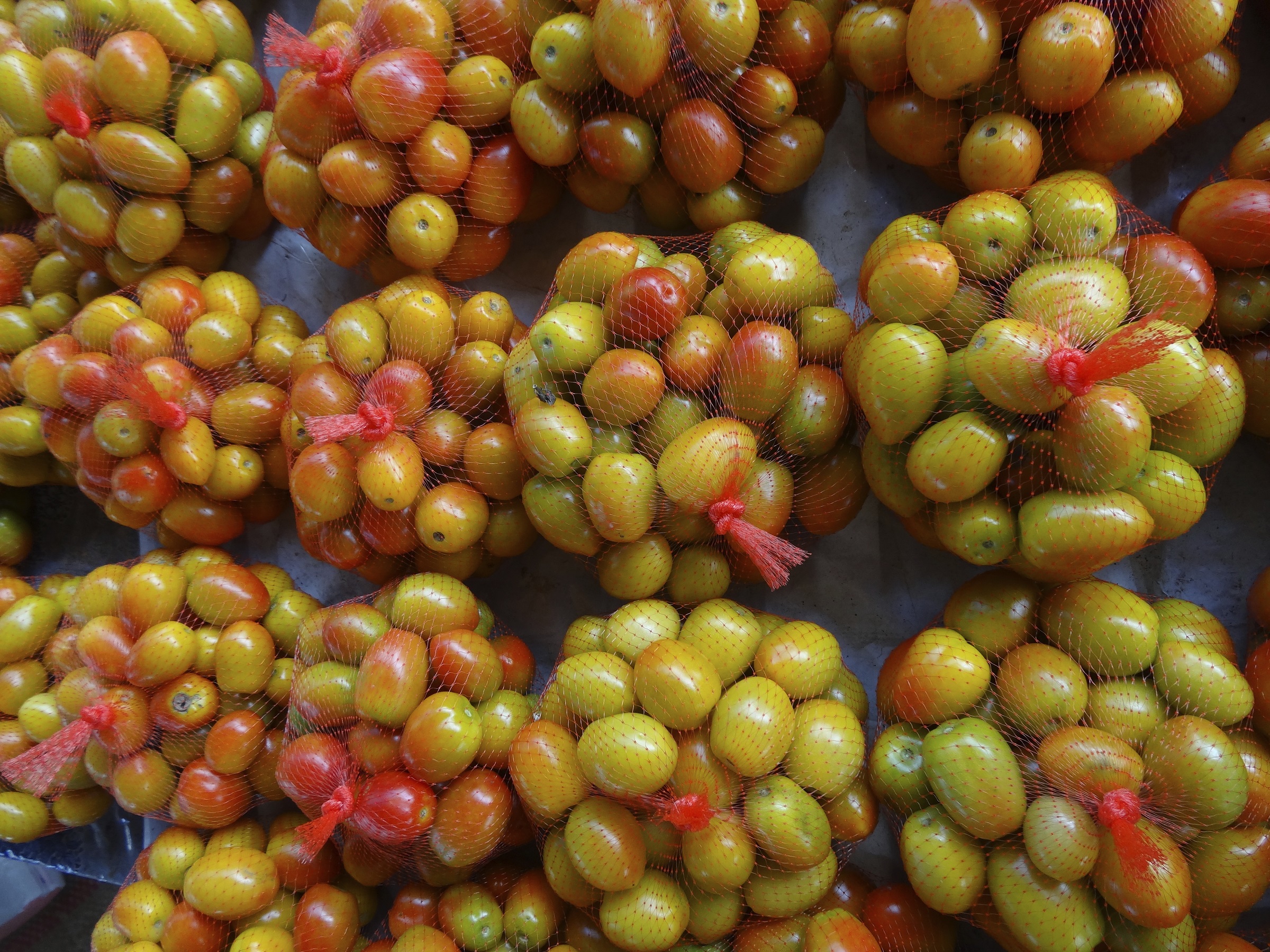
Tiffany Carroll
November 24, 2020Every year I desperately look forward to the tomato season, when the local market stalls are filled with organically grown, sun-ripened tomatoes with their bright red colour and sweet and gently tangy flavour, from tiny cherry tomatoes to the huge fleshy ox heart or beefsteak ones.
A member of the nightshade family (along with aubergines, peppers and chillies), tomatoes are in fact a fruit, but their affinity for other savoury ingredients means they are usually classed as a vegetable.
Tomatoes and their use as a food originated in Central America, crossed the Atlantic to Spain with the conquistadors in the 16th century but only finally caught on in northern Europe in the 19th century. The Nahuatl (Aztec language) word ‘tomatl’ gave rise to the Spanish word ‘tomate’, from which the English word ‘tomato’ originates. The Mexicans call it ‘tomatillo’, the Italians ‘pomodoro’ (apple of gold) and in the Austrian and Bavarian dialect it is similarly called ‘Paradeisapfel’ (apple of paradise).
The scientific name lycopersicum means ‘wolf peach’, and comes from German werewolf myths. These legends said that deadly nightshade was used by witches and sorcerers in potions to transform themselves into werewolves, so the tomato’s similar but much larger fruit, was called the wolf peach when it arrived in Europe.
Today they’re one of the most important ingredients available and are especially indispensible in Mediterranean cookery. The skin, flesh and seeds can all be eaten, but the green leaves are toxic, so should always be discarded.
When buying tomatoes, choose the best! Go for firm tomatoes with wrinkle-free skins and a noticeable tomato smell. Tomatoes have the best, sweetest flavour if they’ve been allowed to ripen on the vine before they’ve been picked but, if you buy under-ripe tomatoes, you can redden them by keeping them in a brown paper bag at room temperature.
The type of tomato you buy depends on what you intend to do with it. There are thousands of different types, but here are some of the most common types.
Cherry: small and very sweet with intense flavour. They are good in salads, pasta sauces or roasted.
Plum or Roma: Available as a baby or full-grown tomato, plum tomatoes have an oval shape, with a rich flavour and comparatively few seeds. Good for making sauces and stews.
Medium round tomatoes: also known as salad tomatoes are good all-rounders in the kitchen.
Ox heart or beefsteak: these are the biggest tomatoes, and have a meaty texture with a sweet, mellow flavour. They are good for salads, grilling or stuffing.
Green: there are two types of green tomato. One is unripe, and is quite tart but good for chutneys, or frying. The other is a variety that stays green when ripe (often labelled Kumato), has a tangy flavour and is good in salads or, again, fried.
Yellow: these ripen to a golden yellow colour, and are good in salads, salsas and chutneys. Storage: Chilling tomatoes mutes their flavour so, unless they are very ripe, they should be stored at room temperature. If you won’t be eating ripe tomatoes for a couple of days, put them in the fridge in a perforated bag, but take them out of the fridge for about 30 minutes before eating, so that they can warm up.
Preparation: Wash, and then leave whole or halve, quarter, slice, chop or dice, as required. If you want to remove the skins before making them into a sauce, cut out the green stalk and core at the top of the tomato, cut a small, shallow cross at its base, then put them in bowl and cover with boiling water. Leave to stand for 20 seconds, then drain. When they are cool enough to handle, pull away the loosened skin. Tomatoes are also available tinned and if they are not in season and are best used for cooking.
Cooking: There are many ways to use tomatoes. Raw in salads, roasted whole, halved and grilled, sliced and fried or used in sauces, stews, soups and salsas. Tomato juice is a popular drink and used in cocktails such as Bloody Mary.
Here are some of my favourite recipes:
Tarte aux tomates et a la moutarde (Tomato and mustard pie)
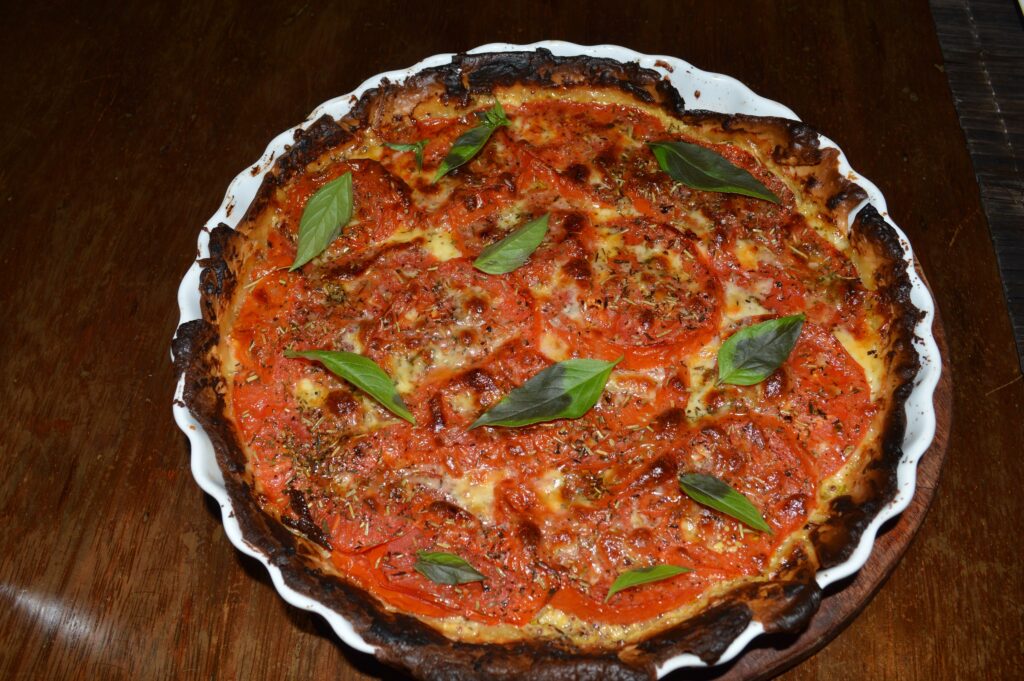
This tarte is a dish from Lyon, which is considered the gastronomic capital of the world. It is a typical Lyonnais dish and one of my favourites during the tomato season.
Ingredients
• Unsweetened shortcrust pastry
• 1/2 cup Dijon mustard
• 2 -3 large ripe ox heart tomatoes, sliced 0.5 cm thick
• 6 slices Gruyere cheese, about 0.5 cm thick
• 1 tablespoon olive oil, or as needed
• 2 tablespoons Herbes de Provence
• Fresh basil leaves
Method
• Preheat oven to 190 degrees C. Fit the short crust pastry into a 23 cm pie dish. With a fork, poke holes into the bottom of the crust.
• Spread the mustard over the bottom of the piecrust in an even layer.
• Cover the mustard with the Swiss cheese in a layer
• Arrange slices of tomato, overlapping in a spiral from the edge to the centre, covering the cheese.
• Drizzle olive oil over the tomatoes, and sprinkle the tart with the Herbes de Provence.
• Bake in the preheated oven until the crust has browned, the cheese has melted, and the tomatoes are curled at the edges, about 20 minutes.
• Decorate with fresh basil leaves
Caprese with Balsamic reduction
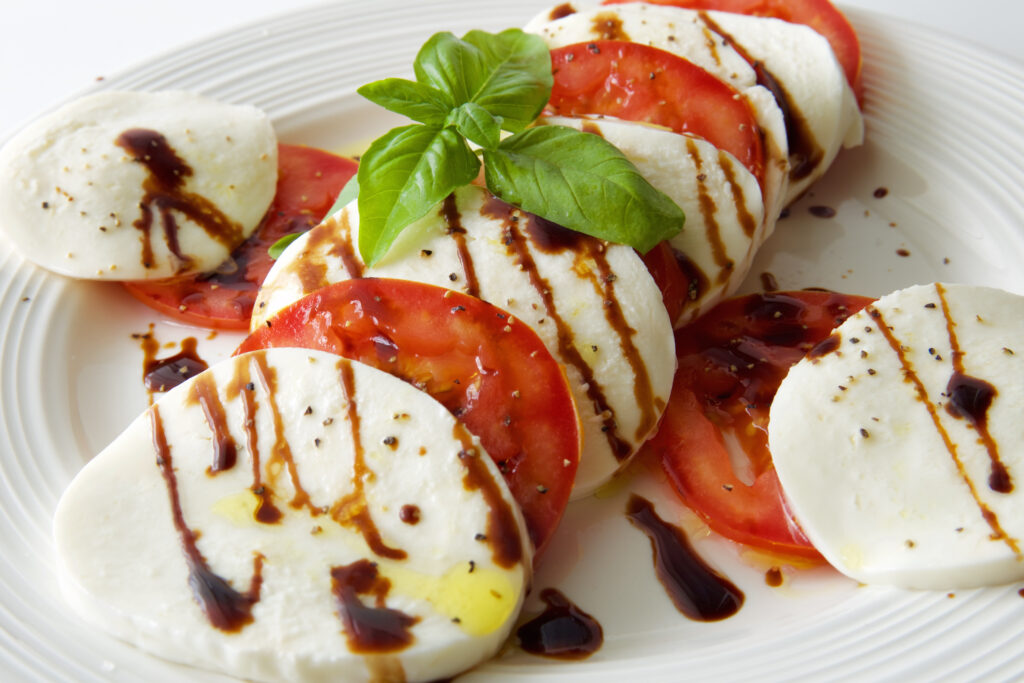
Tomatoes, fresh mozzarella (if possible di buffalo), and basil drizzled with a sweet balsamic glaze and olive oil. Easy, impressive and delicious!
Ingredients
• Balsamic glaze (available in deli stores)
• 3 large tomatoes, cut into 1 cm slices
• 450 g Mozzarella di Buffalo, or fresh mozzarella
• 1/4 teaspoon salt
• 1/4 teaspoon ground black pepper
• ½ cup fresh basil leaves
• 1/4 cup extra-virgin olive oil
Method
• Arrange alternate slices of tomato and mozzarella cheese decoratively on a serving platter.
• Sprinkle with salt and black pepper
• Spread fresh basil leaves over the salad, and drizzle with olive oil and the balsamic glaze.
Sugo di pomodoro (Tomato sauce)
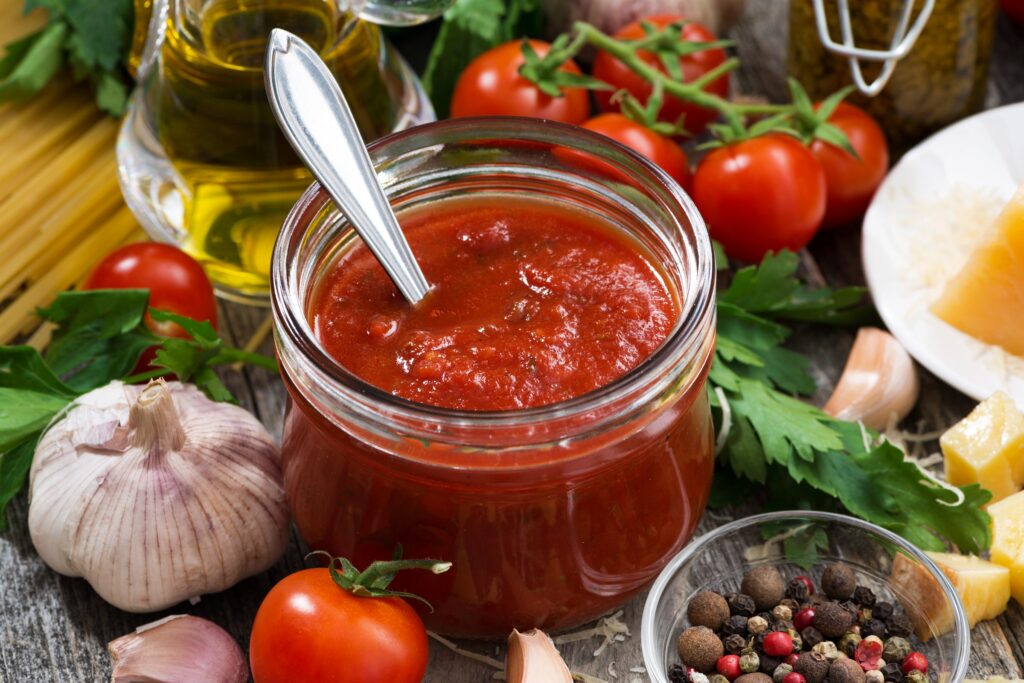
This is my version of the classic Italian sugo di pomodoro. It is handy to have standing by for use in many recipes. I make it in big quantities and preserve it in sterilized jars or freeze it in portions. With some small variations it makes a great tomato soup, pasta sauce, I also use it for Parmigiana di Melanzane (Eggplant Parmigiana), pizza and much more. If the tomatoes are not in season, use Italian canned tomatoes which have the full flavour of sun ripened tomatoes and are perfect for this recipe.
Ingredients
• 3 kg ripe Roma tomatoes, peeled or 3 x 450 g cans of peeled tomatoes and 3 x 450 g cans of crushed tomatoes.
• 1 head of garlic, peeled and crushed
• 1 big onion, diced
• 1 sachet of tomato paste
• ¼ cup olive oil
• 5 anchovies
• Couple of hot chillies or more to taste, seeded and finely sliced
• 1 cup fresh basil leaves
• 1 Tsp. dried oregano
• 1 Tbsp. of chicken stock powder or more to taste
• 1 Tbsp. sugar
• Sea salt and freshly ground black pepper to taste
Method
• Heat the olive oil in a casserole, add the onions and garlic and stir until sautéed but not browned
• Add the tomatoes, chilli, oregano, tomato paste, anchovies and chicken powder and sugar and stir well
• Simmer for 40 minutes
• Add salt and pepper to taste
• Tear and add the basil leaves
• Use as a pasta sauce. Or cool and store in 500 ml containers and freeze.
Ratatouille Nicoise
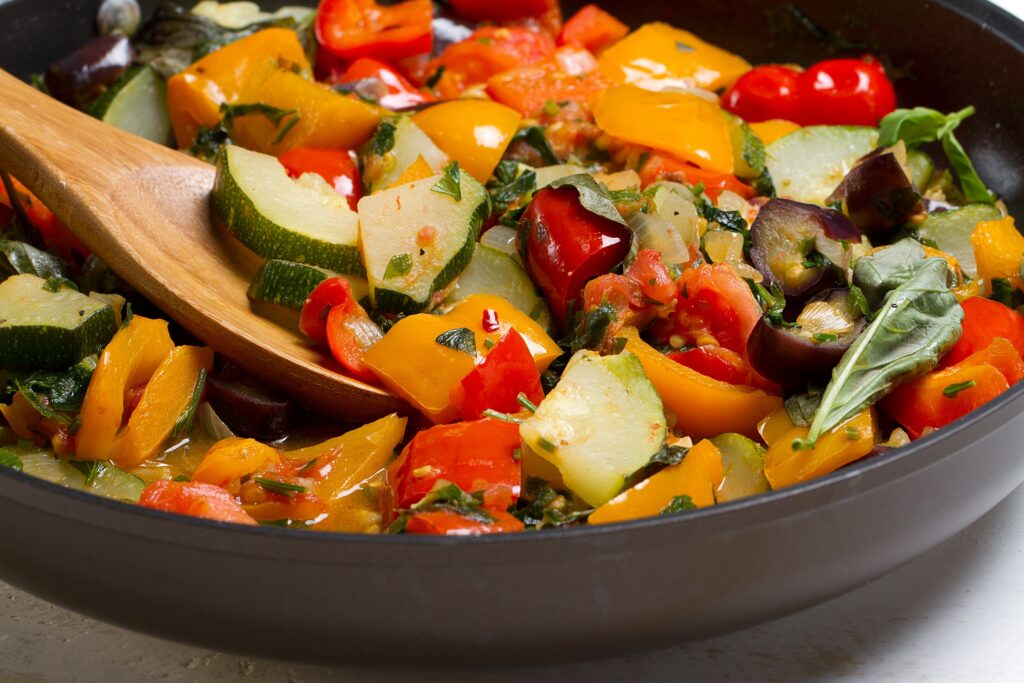
Ratatouille is a true classic of French cooking, a traditional dish from Nice in the South of France. It’s name comes from the verbs tatouiller and ratouiller, which both have their root in the verb touiller, meaning ‘to stir up’, because this is what you do when making ratatouille. Tomatoes are one of the star ingredients and when they are at their best the markets are full of delicious summer vegetables which together make this colourful vegetable stew, simple, rustic but really delicious. It is the quality of the tomatoes that makes the difference, which is why it is so important to make this dish at the peak of the season, when tomatoes are ripe and sweet. The key is to simmer it for at least 1 hour uncovered and let the flavours develop. The longer it cooks the better it is and it is even better reheated. I like to add a dash of balsamic glaze before serving, but that is up to you. Enjoy it with a nice loaf of Pain de Campagne or serve it with fish or grilled meat. You can eat it warm or cold, which makes it perfect for summer barbecues.
Ingredients
• 1 kg ripe tomatoes, peeled (Roma preferred)
• 6 small courgettes
• 2 small aubergines
• 3 onions, roughly chopped
• 1 chilli (optional)
• 5 garlic cloves, roughly chopped
• 1 yellow pepper
• 1 red pepper
• 1 green pepper
• 1 Tbsp. parsley, chopped
• 1 bay leaf
• 1 Tsp. fine sugar
• ¼ cup olive oil
• Salt and pepper
• Fresh basil or parsley to garnish
Method
Prepare the vegetables
• Wash the peppers, seed them and cut into small cubes
• Peel and dice the aubergines, sprinkle with salt and set aside
• Take out the seedy part of the courgettes and cut into 1 cm rings
• Make incisions on the top of the tomatoes, drop them for 20 seconds into boiling water, drain, peel, cut in half, take out the seeds and cut them into quarters Cooking the vegetables
• Heat ½ the olive oil in a thick-bottomed casserole
• Add the zucchinis and aubergines and sauté for 5 minutes or until golden, stirring all the time. Set aside.
• Add the other ½ of the olive oil to the casserole; add the garlic, chilli, peppers and onions. Stir and cook for 10 minutes.
• Add the tomatoes and mix well. Cook for 10 minutes stirring regularly, before adding the zucchinis and aubergines.
• Season with salt and pepper.
• Add the chopped herbs, the bay leaf and the sugar, and simmer uncovered on low heat for 1 hour.
• Sprinkle with fresh basil leaves or parsley before serving
© 2024 Pacific Island Living Magazine all Rights Reserved
Website by Power Marketing